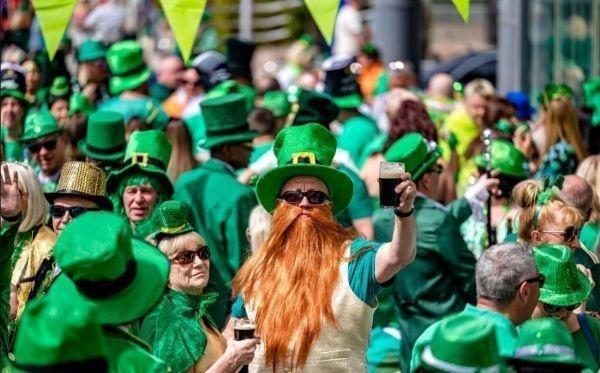Saint Patrick´s Day in Benidorm
MARCH 17th - Saint Patricks Day Benidorm, the day when Benidorm turns into a sea of green fancy dress outfits and gallons of Guinness is drunk.
St Patrick´s day is NOT an official festival day for the Spanish but 1000s travel to Benidorm to enjoy the atmosphere and the cheap beer. There is NO organised parade but there is generally more daytime entertainment provided, use the WHATS ON GUIDE to see who is performing when and where.
Most people visiting will take the opportunity to dress up in fancy dress but it is not obligatory but wearing something green will make sure you fit right in.

Whether you are Irish or not, why not come over and see for yourself, join in the fun and have an unforgettable St Patrick’s day in Benidorm!
One of the other reasons this is such a popular week here in Benidorm for ALL nationalities is that St Patrick´s day falls during one of the main Spanish Fiestas here, THE FALLAS and it more often than not coincides with Cheltenham week, so there is something here for everyone, fun, sport and culture.
Where to Watch Sport in Benidorm
Saint Patricks Day Benidorm
What is the weather like in March? Check the daily weather HERE

SPRING STARTS 20th 2023
Daylight saving time 2023 in Spain will begin at 2:00am March 26th
Temperature 14°C 57°F
Low Temperature 9°C 48°F
High Temperature 19°C 66°F
Sunshine Hours 9 hrs
Chance of Sunny Day 44 %
Rainfall 23mm
Rainfall days 7 days
Chance of Rain 18 %
Chance of Cloudy Day 18 %
Sea Temperature 15°C 59°F
Chance of Windy Day 18 %
Saint Patricks Day Benidorm
St Patrick´s day FACTS
1. What Do We Celebrate On Saint Patrick's Day?
St. Patrick's Day started out as a feast day for St. Patrick, the patron saint of Ireland. A feast day is pretty much just a celebration, usually in the Christian faith, that is commemorated with a meal. People traditionally celebrated St. Patrick's Day by attending mass and thinking about the life and legacy of St. Patrick.
2. Who Was Saint Patrick?
These days, St. Patrick's Day celebrations don't have much to do with the man for which the holiday is named. Nonetheless, he is an important figure in Irish Catholic history. Ironically, St. Patrick wasn't even Irish. He was born in Britain around A.D. 390 to an aristocratic Christian family. According to folklore, St. Patrick was kidnapped and brought to Ireland at 16, but he escaped and was reunited with his family in Britain at the encouragement of a voice he heard in his dreams, which later told him to go to Ireland. St. Patrick became a priest and then spent the rest of his life converting the Irish to Christianity.
3. Did He Really Get Rid Of All Of The Snakes In Ireland?
One common myth about St. Patrick is that he drove all of the snakes out of Ireland. Sure, there are no snakes in Ireland today, but there actually never were. The frigid waters that surround Ireland made it too cold for snakes to arrive there from Britain. When literature mentions St. Patrick getting rid of all of the snakes in Ireland, it is probably just a metaphor for ridding the country of its "old, evil, pagan ways."
4. Why Is Saint Patrick's Day On March 17?
We celebrate St. Patrick's Day on March 17 every year, but why is that? No, it's not just to have a holiday in March, which is usually a dull month in terms of major celebrations. The date commemorates the day St. Patrick died, believed to be in A.D. 461. Upon his death, St. Patrick was mostly forgotten. However, a mythology grew around the religious figure, and by the 9th or 10th century, people in Ireland began observing St. Patrick's Day as a feast day.
5. When Did It Become All About Partying?
So as you can see, St. Patrick's Day was a pretty tame holiday in the beginning. In fact, it was a minor religious holiday in Ireland until the 1970s. Pubs even closed on March 17 in Ireland every year until the 1970s. We can trace some of the modern revelry associated with St. Patrick's Day to the fact that prohibitions on eating meat, drinking and dancing during Lent were lifted for the day.
However, America is responsible for turning St. Patrick's Day into the big party we know and love today, which is totally not surprising. There's some debate over when the first St. Patrick's Day parade took place, but early celebrations happened in Boston in 1737 and New York in 1762. St. Patrick's Day celebrations continued to grow as more and more Irish immigrants came to the U.S., especially after the Irish Potato Famine hit in 1845. Today, there are celebrations in many small towns, big cities and bars across the country. New York's St. Patrick's Day parade is the world's oldest civilian parade and the largest parade in the U.S., Chicago is also famous for dyeing the Chicago River green every year for its St. Patrick's Day celebration.
6. Why Do We Wear Green?
At any St. Patrick's Day event you attend these days, you will just see a sea of green. There isn't really one reason why this is the official color of St. Patrick's Day, but the color green has a lot of connections to Ireland and springtime. It's featured in the Irish flag, Ireland is nicknamed the "Emerald Isle," it represents spring and it's the color of shamrocks, The Christian Science Monitor points out. That wholly American tradition comes from the idea that people thought wearing green helped ward off being pinched by leprechauns (seriously). Leprechauns would pinch anyone they could see, i.e. anyone not wearing green.
8. Why Are Shamrocks A Thing?
According to legend, St. Patrick used shamrocks, those three-leaf clovers, to explain the Holy Trinity of the Father, the Son and the Holy Spirit while trying to convert people to Christianity, people didn't really start wearing shamrocks until as early as the 17th century.
9. Are Leprechauns Real?
No, of course not! Why would you ask such a thing? However, leprechauns do have a rich history in Irish folklore. Tales of these little fairies were passed down from generation to generation. They were said to be "shoemakers who socked away their profits in pots at the end of rainbows, or scattered them around in mountains, forests, or rocks," It is said that people have looked for leprechauns to get a piece of that gold and because they're rumoured to bring good luck.
10. What's The Deal With Corned Beef And Cabbage?
Even if you don't know anything about Irish culture, you've probably heard that corned beef and cabbage is a traditional Irish dish eaten on St. Patrick's Day. However, the corned beef part of the meal actually used to be bacon because cows were actually not generally used for their meat in Gaelic Ireland but their strength in the fields and their milk. Corned beef and cabbage is really an American creation, which originates from Irish immigrants in New York buying the meat from kosher butchers. The traditional St. Patrick's Day meal in Ireland is still lamb or bacon.
Join the Benidorm Seriously Facebook Group
Enjoy Saint Patricks day in Benidorm



